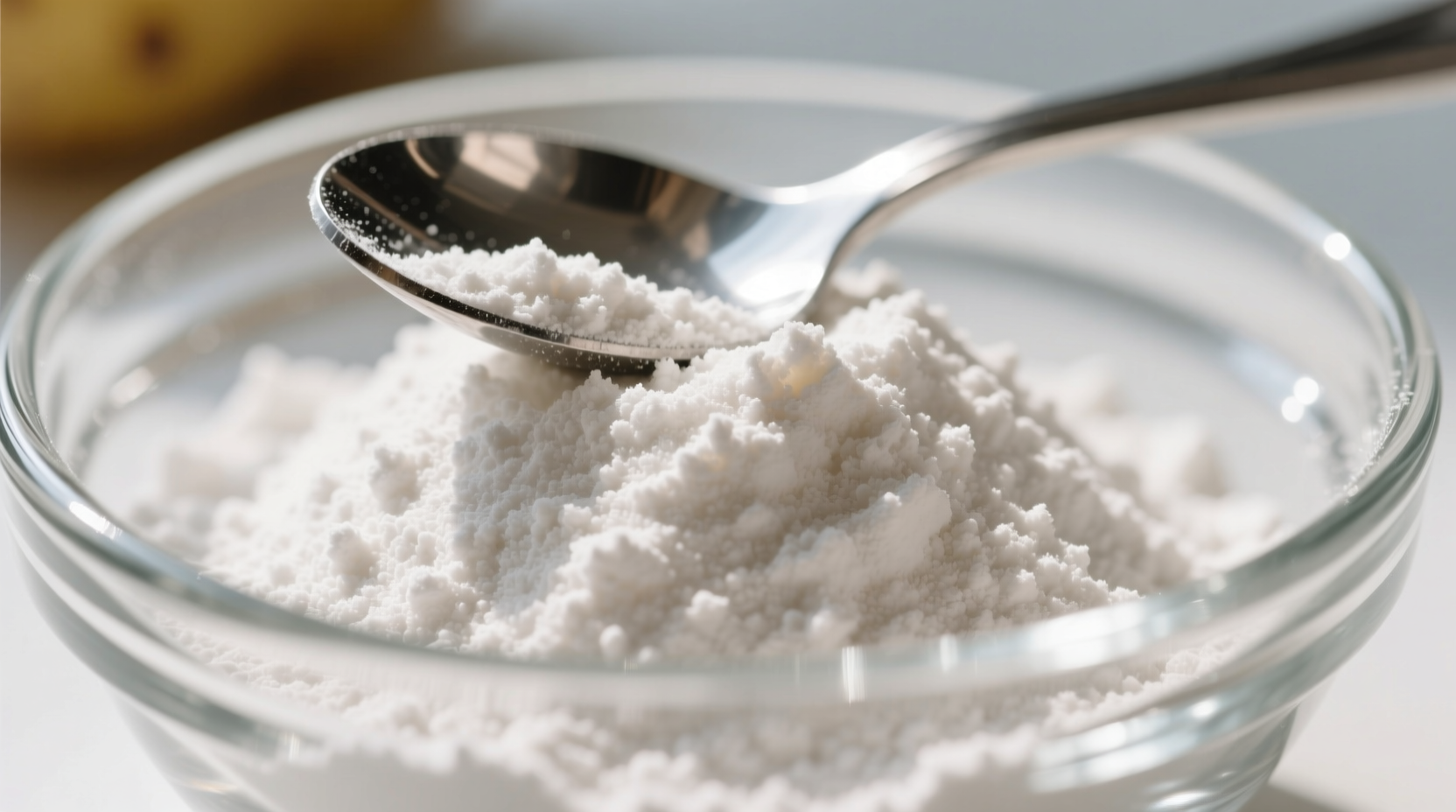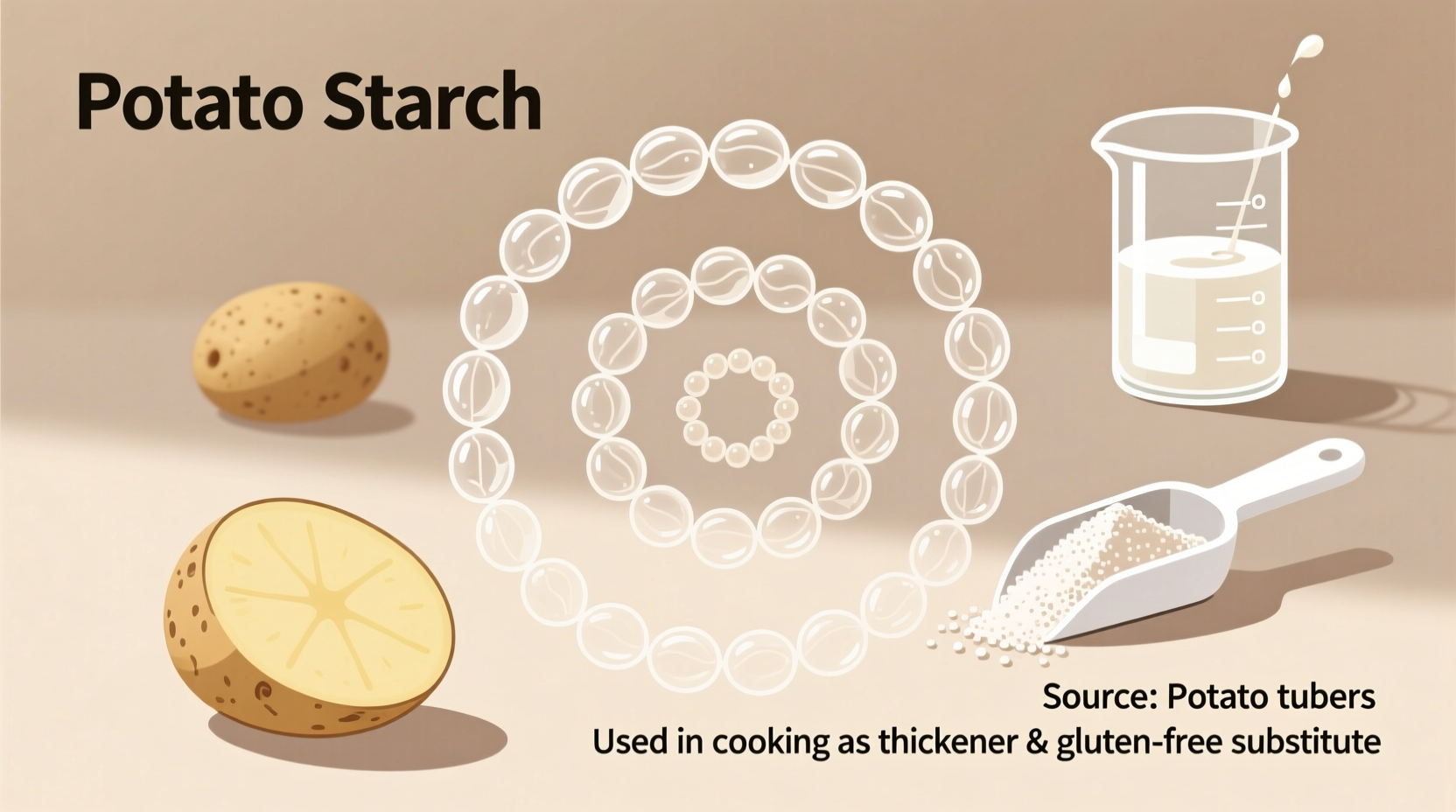Potato starch is a fine, white powder extracted from raw potatoes through a process of washing and pulping. It serves as a powerful thickening agent in cooking and baking, with twice the thickening power of wheat flour and superior clarity compared to corn starch. This gluten-free starch maintains viscosity at high temperatures and performs exceptionally well in frozen applications, making it indispensable for sauces, soups, and gluten-free recipes.
Understanding what is potato starch and how it works can transform your cooking results. Unlike potato flour, which contains fiber and protein from the whole potato, pure potato starch consists almost entirely of carbohydrates extracted from the starchy parts of the potato. This fundamental difference explains why potato starch excels as a thickener while potato flour behaves more like a standard flour in recipes.
The Science Behind Potato Starch Composition
Potato starch consists primarily of two carbohydrate polymers: amylose (20-25%) and amylopectin (75-80%). This specific ratio gives potato starch its unique properties that distinguish it from other common thickeners. When heated in liquid, the starch granules absorb water, swell, and eventually burst, releasing these polymers to create viscosity. The process, known as gelatinization, occurs between 130-140°F (55-60°C) for potato starch—lower than corn starch but higher than wheat flour.
According to research from the US Department of Agriculture, potato starch contains approximately 87% carbohydrates, with minimal protein and fat content. This composition makes it an excellent choice for those requiring gluten-free alternatives while maintaining neutral flavor in dishes.
How Potato Starch Is Produced: From Field to Kitchen
The commercial production of potato starch follows a precise timeline that has evolved significantly since its development in the late 18th century:
- 1780s: First documented extraction methods developed in Germany
- 1830s: Industrial-scale production begins in Europe
- 1850s: Introduction of centrifugal separation improves purity
- 1950s: Development of modified potato starch varieties
- Present: Advanced washing and separation techniques yield 99.5% pure starch
Modern production involves harvesting potatoes, washing them thoroughly, crushing to release starch granules, separating the starch from fiber and protein through sedimentation or centrifugation, and finally drying the purified starch into powder form. This careful process preserves the starch's functional properties while removing impurities that could affect performance.
Practical Applications in Cooking and Baking
When exploring what is potato starch good for, professional chefs value it for specific culinary applications where other thickeners fall short:
- Sauces and gravies: Creates crystal-clear finishes without cloudiness
- Frozen foods: Maintains texture through freeze-thaw cycles better than corn starch
- Gluten-free baking: Improves moisture retention and texture in breads and cakes
- Asian cuisine: Essential for proper texture in dishes like Korean pancakes and Chinese stir-fry sauces
- Dairy applications: Works well in milk-based sauces without breaking down
Antonio Rodriguez, culinary expert with extensive experience in ingredient chemistry, explains: "Potato starch's large granule size gives it superior water-binding capacity. When properly incorporated as a slurry, it creates a glossy, smooth texture that holds up to prolonged cooking—something corn starch can't match in extended simmering applications."

Key Differences: Potato Starch vs. Similar Products
Understanding the distinction between potato starch and related products prevents common kitchen mistakes. The following comparison highlights critical differences:
| Property | Potato Starch | Corn Starch | Potato Flour |
|---|---|---|---|
| Source | Starch granules from potatoes | Starch from corn kernels | Whole dried potatoes |
| Color | Bright white | Slightly yellowish | Tan to light brown |
| Thickening Power | Highest (2x flour) | High (1.5x flour) | Moderate (similar to flour) |
| Gel Temperature | 130-140°F (55-60°C) | 180-190°F (82-88°C) | 140-150°F (60-65°C) |
| Freeze-Thaw Stability | Excellent | Poor | Fair |
| Flavor Impact | Neutral | Slightly sweet | Distinct potato flavor |
When Potato Starch Works Best (and When to Avoid It)
While versatile, potato starch has specific context boundaries that determine its effectiveness:
Ideal applications:
- Clear fruit pie fillings that maintain shine
- Asian-style stir-fry sauces requiring glossy finish
- Gluten-free pasta dough for improved elasticity
- Cold preparations like no-bake cheesecakes
- Frozen meal components requiring texture stability
Limited effectiveness:
- Acidic mixtures (vinegar-based sauces) above 5% acidity
- Long-simmered tomato sauces (breaks down after 30+ minutes)
- Dairy sauces cooked above 180°F (82°C) for extended periods
- Recipes requiring significant browning (burns at lower temperatures)
Proper Usage Techniques for Optimal Results
Mastering how to use potato starch properly prevents common issues like lumping or thinning:
- Create a slurry: Mix 1 part starch with 2 parts cold liquid before adding to hot mixtures
- Add at correct temperature: Incorporate when liquid reaches 130-140°F (55-60°C)
- Avoid overcooking: Remove from heat once thickened to prevent breakdown
- Don't freeze immediately: Allow cooked mixtures to cool slightly before freezing
- Store properly: Keep in airtight container away from moisture and heat
For gluten-free baking, replace 15-20% of the total flour weight with potato starch to improve moisture retention without compromising structure. In sauces, use half the amount you would corn starch due to its superior thickening power.
Nutritional Profile and Storage Guidelines
According to USDA FoodData Central, one tablespoon (8g) of potato starch contains:
- 30 calories
- 7g carbohydrates
- 0g protein
- 0g fat
- 0g fiber
- Negligible vitamins and minerals
Unlike whole potatoes, potato starch lacks significant nutritional value beyond carbohydrates, functioning primarily as an energy source. Those managing blood sugar should note its high glycemic index (approximately 85), similar to white bread.
Proper storage maintains potato starch's effectiveness. Keep it in an airtight container in a cool, dark place for up to 12 months. Exposure to moisture causes clumping and reduces thickening ability. Refrigeration isn't necessary but can extend shelf life in humid environments. Discard if you notice any off odors, discoloration, or evidence of pests.
Common Substitutions When Potato Starch Isn't Available
When determining what can replace potato starch, consider these alternatives with their limitations:
- Corn starch: Use 1.5x the amount; creates slightly cloudy results and breaks down faster in frozen applications
- Tapioca starch: Use equal amount; provides similar clarity but creates chewier texture
- Arrowroot: Use equal amount; works well in acidic preparations but produces slimy texture if overheated
- Rice flour: Use 2x the amount; creates opaque finish and requires longer cooking to eliminate raw flavor
No substitute perfectly replicates potato starch's unique properties, particularly its freeze-thaw stability and neutral flavor profile. For critical applications like gluten-free baking or clear fruit fillings, seeking authentic potato starch yields superior results.











 浙公网安备
33010002000092号
浙公网安备
33010002000092号 浙B2-20120091-4
浙B2-20120091-4